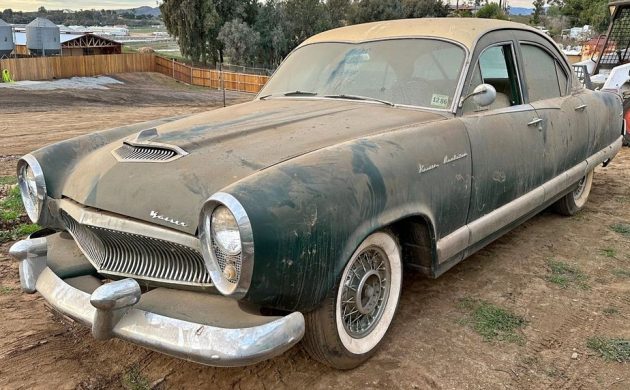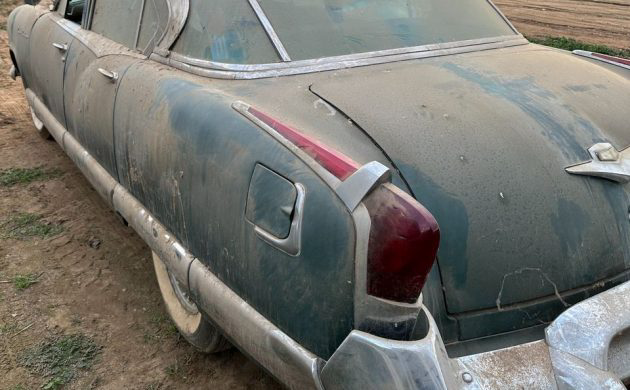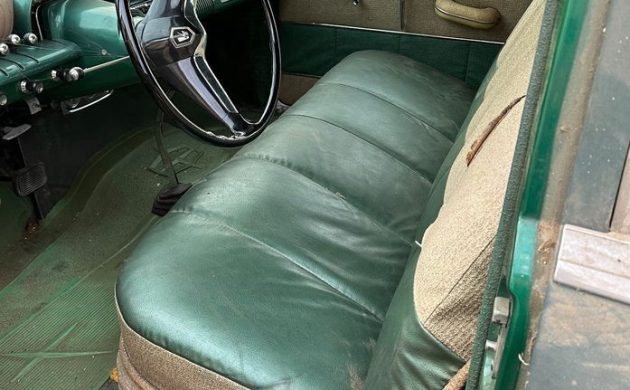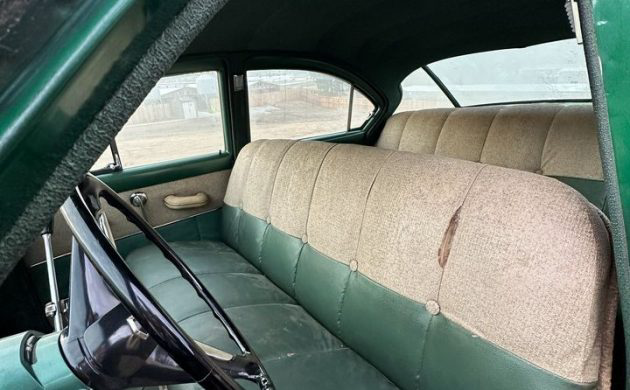One of the new nameplates to emerge after World War II was the Kaiser. Bankrolled by shipbuilding magnate Henry Kaiser, the brand attracted a lot of attention and sales when automobile production resumed but fell behind the other offerings on the marketplace as the fifties rolled on. One of their biggest issues was the lack of a V-8 powerplant. However, that didn’t stop one Kaiser fan from making his dream car. If you are looking for a Kaiser with a little more get up and go under the hood, then you might want to peruse the ad for this 1955 Kaiser Manhattan for sale on Facebook Marketplace in San Diego, California. Under the hood lurks a 283 Chevrolet V-8 that was transplanted in the sixties by a well-respected Kaiser guru. With factory wire wheels and enough barn dust to clog a HEPA filter, this Kaiser is being offered at a heady $9,500. Is that a reasonable price for a Kaiser with a little extra power under the hood? Thanks to T.J. for this fascinating find!
The automotive market in the United States changed a lot between the close of World War II and the end of 1955. The country was finally at peace, and there was a considerable amount of money saved during the war by both people stateside with little to spend it on and the servicemembers who had accumulated pay during their time fighting for our country. The quick surrender of Japan after Hiroshima and Nagasaki caught a lot of manufacturers flat-footed. A total invasion of the Japanese home islands was what had been on deck, and that was expected to take more time and a whole lot more sacrifice. That surrender and the sudden cancellation of military contracts started a mad rush to begin the manufacture of automobiles again.
The “Big Three” quickly got back in production with warmed-over cars from the prewar era. To their credit, they had been preoccupied producing large, complex military projects such as tanks and planes. They also didn’t have much ability during that time to build and test new designs, let alone set up for manufacturing with complex dies and the other items needed to field new cars. This was not as big an issue for some of the smaller independents. Those that survived the Depression and the subsequent war were able to respond quicker, and a few came out with all-new designs. Crosley’s offering was brand new from front to back, and from the ashes of Graham-Paige came the new Kaiser-Frazer Corporation with a mostly new car.
Kaiser-Frazer’s bathtub body style looked very modern compared to other offerings, and it was a hit even in a seller’s market. The company appeared to have a bright future. However, as the seller’s market slowly morphed into a buyer’s market as demand was satisfied, the advantages that larger automakers had over smaller ones started to rear their ugly heads. They had the financial ability to develop new products and come out with improvements at a pace and scope that the independents simply couldn’t match. One of those improvements was a V-8 engine. While Ford introduced an all-new car in 1949, it still had a Flathead under the hood. Oldsmobile came out with a freshly designed V-8 in 1949, and that engine spurred the public’s clamor for modern V-8-produced horsepower.
Even with a complete and distinctive restyle in 1951 and the added option of a supercharger in 1954, Kaiser and it’s inline six could not compete. By the time Chevrolet came out with their new V-8 in 1955, Kaiser was throwing in the towel. Sagging sales couldn’t support this promising independent passenger car sales any longer. Kaiser had purchased Willys-Overland to acquire the Jeep brand, and that would be the company’s focus from that point on. The dies for the Kaiser car ended up in Argentina, where a version was produced. The last Kaiser automobile produced in the United States rolled off the assembly line in late 1955.
We don’t know a whole lot about this distinctive green 1955 Kaiser Manhattan, other than it was likely one of the last to be produced. The fact that it is a Manhattan makes it possible for this car to have been equipped with the optional supercharger. Not that it matters anymore. The special secret in this Kaiser is what a fellow named Terry Zeug who owned the car installed under the hood. Mr. Zeug was an early Kaiser Frazer Owners Club member and even he wanted more horsepower when he modified this car in the early sixties. That motivation is provided by a 283 cubic inch Chevrolet V-8 backed by a three-speed manual transmission with overdrive.
Additional positive features about this car are that it is a California car with no rust, and it has a set of rare Kaiser factory wire wheels. It is fresh out of long-term storage, and it is said to run and drive well. The barn dust will also come with the car free of charge.
In all, this is a very interesting car in a captivating (if cleaned up) color. If your heart isn’t set on keeping the wire wheels, I would imagine they could be sold to offset the costs of the purchase. From there, you have a car that is set up to take a small block, Chevy. If you don’t know what to do from there, I cannot help you!








A unique ‘50’s car with a ‘60’s HP solution. Neat looking car, though the seller would probably get more interest if it were just hosed off, let alone cleaned up.
Kaiser had been working on a V8 at the time, but it was too late. Several engineers were acquired by AMC, and 18 months later, they had a new engine in what was record time them.
A car like this is better left in original condition, in my opinion. So what if the original 6-cylinder engine wasn’t quick, is a 283 gonna make that much difference?
And, as always, why don’t people wash cars before selling them? As if that dust is some kind of magic dust?
That 283 in its most basic tune was good for 185 hp, while the flat head six was at 116 hp, or 140 with the supercharger. Not to mention the 283 was the first engine out of Detroit capable of one hp per cubic inch with the Fuel Injection of the time. With a short stroke high rise rpm to help on the highway, after the flatheads had all ran out of breath.
I know purists will scream bloody murder, but I think it’s the most plausible way to enjoy an older car like this, except it should have an automatic. With the unusual stylings of the 50s, it must have been great being an auto designer. Any half baked design was tried. These pushed the limits and at the time, Americans were happy with shoe box Fords. This, not so much. Again, an automatic should be a simple swap, and would greatly increase who might want an unusual looking car like this today. Some gray or no hair? Nah, they’re buying the Corvette of their faded dreams, this would be more for someone who thinks outside the box, but has no idea who Kaiser was, or the fact we’re probably not speaking German because of him.
Wow that is a great swap, kept the stock appearance yet able to hit the open highway and not worried if the internals come spilling out the bottom. Always appreciated the glass in these cars, the design was unlike any other before and since.
what great lines, unique! a deal at what seems like a complete car. detail it and drive it! enjoy life!
Rex, I had a 284 in my 57’ Chevy PU. Absolutely a hi-rpm gem. Easy and cheap little mouse motor that can generate well over 300hp. It would make a big diff in my opinion. I think the hype about unwashed vehicle is that folks perceive the car to be an untouched time capsule. Not the case in this example, clearly been touched to drop that Chev drivetrain in.
My great friend has over 300 kaiser/ fraizers . He has been collecting cars for over 30years. He sold his moms 59 wagon ( 20000 original miles) to but another 100 parts cars and a warehouse full of parts! So if anyone needs any parts for these cars He is the guy! I was going through his yard and spotted a 2 door 51. It also had a transplant motor. Some one put a buick nail head v8 and a 3 speed on the floor! Thought about buying it a couple times!
James,I purchased a 1954 Kaiser early special several months ago. I am in need of several small items for this car. Do you think you could hook me up with him? Thanks, Jim Herron
Kaiser’s failure has always been the “Control Study” to me about Tucker. The fact that a seasoned industrialist, along with Frazier, with decades of experience in the automobile industry could not remain profitable in the post-war environment shows that starting an automobile company in the post war years was tough.
And impossible for an upstart with zero experience and insufficient capital.
The site Ate Up With Motor goes into the Kaiser debacle in depth…exploring how Henry Kaiser teamed up with Joseph Frazer because of Frazer’s experience in the auto industry; and yet, refused to listen to Frazer’s advice or accept his input. Frazer warned, early on, that sales were not meeting projections, and production needed to be reduced. Kaiser was enraged at this. His plan was to build cars without orders, and warehouse them – for a coming wave of buyers he felt sure would emerge.
This cost the company, and more than just in storage space. In later years, stored, unsold cars were re-serialed to be the then-current year models, and trim had to be replaced, extensively, to match current offerings. IIRC the whole of the 1955 model year was re-serialed 1954 unsold models.
Kaiser was a genius in production – in making things happen – but he didn’t understand mass marketing at all, and certainly not as regards automobiles. Apparently he came to realize that – as, when bankrupt Willys-Overland became available for sale, he bought it, thinking he could make it work through the Army and government contracts.
And he was right. Government contracts were his comfort zone. He didn’t understand retail sales at all…it again showed, as Willys Motors, rebranded as Kaiser Jeep, experienced a sudden popularity in private sales. Kaiser and his son, Edgar, did nothing to increase Jeep production, sticking to the one Toledo factory, one line, making all the Jeep products on that same line.
Kaiser’s death sealed that issue, as, in liquidation of his estate, Jeep was sold to American Motors. Who did many things wrong, but knew that capacity had to be increased, and was. Jeep CJs began coming out of Bramlea and military products were moved to a separate, created subsidiary company, made in South Bend, Indiana.
You are correct that the 1955 Kaiser cars were 1954 models with replacement 1955 serial number plates. These cars are actually very rare, as the total sales in the USA of Manhattan sedans for 1955 was 226 vehicles. The 2-door sedans are even harder to find, with the 1955 Manhattan production topping out at a measly 44 vehicles! There were a little over 1,000 additional 1955 Manhattans built, but all were destined for Argentina. And yes, it’s still easier to find a 1955 Manhattan in Argentina than in America!
Gotta wonder where this car is located… I lived in San Diego for 30+ years (1945-79) and remember only two times that snow was on the ground (see photos) – it must be lurking in the Escondido foothills or up in the Laguna mountains area (the map shows the SD city area)… Nothing really special about the wire wheels – no Kaiser-specific hubcaps are shown. Tri-5 lovers might love to grab the 3-speed/OD tied to the 283 (that’s got to be a rare item). Probably a great cars ‘n coffee cruiser for the price.
Although the styling may have been ahead of its time back then, that arched roof will take some getting used to, IMHO. Not a bad price for something that’s guaranteed to draw crowds at your local C&C. And while originality for a car like this will raise the resale value, the V8 raises the cool factor. Just don’t drive it too frequently because body and interior parts are guaranteed to be scarce and super expensive.
A couple notes:
This `55 kaiser appears (overall, anyway) to be quite solid. The interior is in amazing condition, considering the “bamboo” upholstery showing a repairable seam-split on the front seat. I bet the back seat looks like new like most sedans. Me? I’d pull the 283 and find a nice 350 for it–and YES—an automatic to go along with it! Otherwise, I’d restore it to be bone stock looking inside and out, and have a fantastic show-stopper! You never see kaisers at shows today; too many `57 Chevies to crowd them out!!
When this generation Kaiser came out (was it 1951?) I thought it was one of the best-looking designs on the market. I still think they were way ahead of their time. the low waistline with tall sidelights made for a very sleek appearance. My favorites were the ’52-53s. The ’54-55 – models were a bit overly flamboyant – but on their shoestring budget, Kaiser was doing it’s best at making each new-years models distinctive. At a time when America was going V8-crazy, that same shoestring budget kept Kaiser out of the horsepower race. They tried to buck the inevitable with supercharging, but the word “V8” by 1955 was magic. If you bought a new ’55 Chevy or Plymouth with a six, it said something about you; you were poor or stingy and the “V”s on your hood and trunk were missing. And the sound of your engine sucked.
What’s more: by 1955, “B pillars” were out. Monotone color schemes were out. No matter how sensible such cars may have been,if you drove one, socially you were a dweeb.
Kaiser couldn’t/didn’t jettison their “Pillars”.
And the death knells at Kaiser were mournfully tolling.
I’ve always liked Kaisers, have a 50 Traveler hatchback now. But I guess because I’m used to seeing all the other cars of that era, the 51+ Kaisers seemed to have the proportions all wrong, just look kinda awkward.
I don’t know if I’d WANT to socialize with anyone who’d dweeb someone out because of his/her B pillars or solid-color choice of decor.
A friend of mine daylied one of these in the ’80s. He lived in a loft in Downtown L.A., before that was a thing. The car was part of the coolness.
I remember the interior as remarkably spacious.
Kaiser got off to a great start paying top dollar for scarce resources right after WWII, and he filled his showrooms with post war designs quickly. He got off to a great start.
Unfortunately, he kept paying those prices after supply chains adapted back from war materiel to consumer products, putting him at a disadvantage against competition. In 1948/1948, as the majors came back with new models, he did not anticipate decreased sales from increased competition, and over produced cars that didn’t sell. This was a big mistake and proved expensive.
He then sought to corner practical economy cars with the Aero and Henry J, but the Ford/Chevy price war killed him.
They ended passenger car production in 1954, and shipped the Willys tooling to Brazil.
These were available with a supercharged 6 since Kaiser didn’t have the funds to build an 8 cylinder. If somebody wants to buy this car and take it back to a stock powertrain I’ve got a 50 Kaiser motor I’ll give ‘ya….they are all the same except for the early ones where built by continental, later ones by Kaiser, but other than the name on the cylinder head they’re all alike. They continued to build these in Argentina for several years after production stopped in the US.
Kaiser couldn’t/didn’t jettison their “Pillars”. No, I meant “B-pillars”.
BTW: I like this car. With the 283 under the hood, it’s just what it could have been – and Kaiser no doubt would have been around for many more years. FWIW, I remember seeing a new ’54 or ’55 Dragon at a Minneapolis auto show. Bamboo dashboard. Elegant! But that anemic six still lingered under the hood.
Can you imagine this car in a two-door hardtop with a wrap-around windshield and a V8 (especially a high-performance one) and an automatic? Move over folks, the hot new ’55 Kaiser is coming!
that was one of the things that sunk Kaiser, the lack of a V8 engine
By that time, one was on the way.
David Potter had been hired by Kaiser to fast-track a V8 engine into production; but it took time, time Kaiser didn’t have.
The engine still in the design phase, Henry Kaiser purchased Willys-Overland (for the military contracts) and began phasing out Kaiser and WIllys branded cars. Potter was laid off…where the new American Motors Corporation quickly hired him.
He brought the new Rambler V8 out in record time. It was probably fitting that, a decade later, the newly reorganized Kaiser-Jeep chose, at first, to purchase that same engine from AMC, in 327-cubic-inch form.
They keep saying that, but Hudson, Nash, Packard, Studebaker all got V-8’s and didn’t make it. The car business is just so competitive and fickle, even Pontiac and Oldsmobile are gone.
Dare To Be Different.
I’m one of those people who will head over to check out something like this at a car show before looking at the more commonplace vehicles. I can’t explain why I like all of these defunct brands but I do. I’d love tooling around in this. Especially with the O/D manual transmission. In a car of this vintage I always prefer a manual. GLWTS.
Just wash the windows and leave the rest, then you can take it to a car show and say it just came out of the barn,,,probably have alot of people looking at it,,attention getter.
“WASH IT DUMMY!!!” Clean up those rims and find the center caps. I’ll bet this car would look sweet clean. Sell in an instant. Wish I had a better circumstance. It would be in my driveway. Really like the setup with the 283 floor shift.
1955 is the smallest production – rare.
And the upper ridge of the taillights are illuminated for 1955, very cool at night! I’d much rather see this at a car show than the over-exposed common makes.
Because my Dad worked for Kaiser Engineers for 35 years we had 4 Kaisers while I was growing up….’49, ’51, ’53, ’54, two bought used. All slow, ponderous, elegant cars, great on the open road. They all had occasional problems with vapor lock but otherwise never an issue in all the miles, including cross country trips.
My high school car was the ’51, in that bright green color they had, and you can imagine the comments I got from the ’32 and ’40 Ford and the ’50 Olds crowd at school. My sister and I reduced the number of Kaisers on the road by each totaling one.
Would love to have another one today.
These pictures don’t appear to be taken in San Diego as it sure looks like some snow piled up against the buildings in the background?
Labor Day in Atlanta 2014 I saw this identical car at a car show. It still had it’s flathead 6. There were a lot of special design features that the 51-55 Kaisers carried: the windshield brow, the Traveler hatchback, the bling on the Manhattans. But the one that I note on newer cars from the Chevy Impala, the Lexus, the BMW, the MB and others is the C-pillar shape. It’s a beautiful reverse curve. We had a 4 door 51 Traveler when I was young for almost 10 years. I’ve always liked their designs.
Here’s a rear view of that same car. The instance car looks very complete and would likely clean up nicely. I don’t think that the price is outrageous, but maybe a little negotiating could be undertaken. Agree that the 283 could be replaced with a newer SBC and perhaps the front brakes could be upgraded to Wilwood disks (as long as the originality is long gone) and a brake booster…and a TBH transmission too as long as it can be done without much change to the interior. And while we’re at it, 12 Volt upgrade to negative ground?
good thoughts!
I think some writers pointing out the “lack of originality” forget that that horse left this barn about 30 years ago.
I would continue upgrades of this interesting car.
I believe that “Dutch” Darrin designed a lot of Kaiser’s cars. (Obviously, the Kaiser Darrin sports car, with its cut-down doors, his signature..
Clean post-war designs.
If he had developed an 8 earlier……..If he had paid more attention to purchasing costs, and not over-built for 1948-49, he had a chance to make it. The costs of little errors add up quickly…
Yes, I believe that Dutch Darrin was the designer of the 50s Kaisers. Don’t know if he did the Henry J or that other one that they offered (can’t recall the model…not bad looking but different).
I would love to see this beauty all cleaned up and detailed as is. While I have no memory of it, my Wonderful Dad owned a Manhattan with the supercharged engine, plus other tweaks he and his brother in law a toolmaker had done. He said he was pleased with, until he took a 59 Chrysler New Yorker for a test drive. Where he signed the paperwork within 5 minutes after he returned. That car I have some memories of, like a huge clear squared off steering wheel and push button shift. It was a beautiful black coupe with red leather interior. He owned till he traded for a 64 Lincoln 4dr. That turned out to be a lemon that he traded within 3 months, on an amazing 64 Imperial Crown Coupe. The first car I ever drove at 12-14 years old.
buy 1,000 pounds of diet, get a free car!
dirt, not diet
Of course this great car would be well served with complete originality however the 283 looks quite at home and does make it more capable and a heck of a conversation starter.The cast aluminum Corvette style valve covers don’t guarantee anything but the casting # might reveal it to be more valuable to someone restoring a Chevy.
It’s kind of comical ,like something
Out of Rodger rabbit.but beautiful
In It’s own way.
For what it is and how complete, great interior, freshen it up, service it and drive to local events, to much history in it to change anything. Spend hours talking to fellow rodders and they will be in awe.
Wash n’ wear! Cool whip, detail and drive!